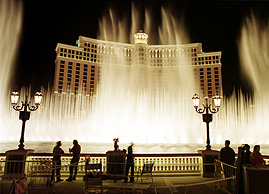CRITIQUE ARCHIVE
http://www.vegas.com/attractions
Vegas, baby, VEGAS!
By Christa StarrFor years, I've been telling people that Vegas has turned into the adult Disneyland. A far cry from the classic Vegas seen in the classic 1960 film Ocean's Eleven (and later re-created in Martin Scorsese's 1995 film Casino), Vegas as a haven for lounge singers and organized crime, today's Vegas is a land of roller coasters and motion rides, wildlife habitats and public parks, upscale shopping malls and art museums. Today's Vegas is a true playground, The Strip a large location-based entertainment experience.
The Disneyland connection is apparently not lost on the designers of the Vegas Attractions (www.vegas.com/attractions) site, which proclaims Vegas as "the
most visited place on earth" (Disney, of course, is "the happiest place on earth"). There are forty attractions listed on The Strip, some of which

are free events like the nightly sinking of the Pirate Ship outside of Treasure Island, others of which require an entrance fee like the made-to-scale recreation of King Tut's tomb at
Luxor. That doesn't factor in the numerous shows, themed nightclubs, bars and restaurants, out-of-town sightseeing trips, and ubiquitous casinos that make up the Vegas world. Like DisneyWorld's Epcot Center, Vegas is also becoming its own "World Showcase." You can visit the cafés of Paris, the canals of Venice, the nightlife of New York, or the 24th century as seen through Star Trek, all in a single night.
In the words of Jean Baudrillard, we are living in an age of simulation, a time in which reality no longer exists, where "the very definition of the real has become: that of which it is possible to give an equivalent reproduction." (Simulations: 1983) Nowhere is this more evident than in the splendors of Las Vegas. Vegas features worlds which never existed - you can shop along the Promenade of Star Trek's Deep Space Nine or dine in a terrace overlooking the Gotham City of Tim Burton's Batman - all sitting alongside attractions modeled after actual earthly physical locations. If your taste for postmodernism is even more extreme, you can visit a re-creation of the stylized Vegas of Ocean's Eleven, conveniently located at the Venetian Hotel's Warner Brothers restaurant, built on the former site of the Sands Hotel (which was featured in the film).
The play between real and simulation runs all throughout Vegas, as it does in Disneyland. Baudrillard focuses on Disney's Main Street USA as a paragon of simulation, "Disneyland is there to conceal the fact that it is the 'real' country, all of 'real' America, which is Disneyland." (Simulations) He is warning us that we visit these sites of spectacle and simulation to help us ignore that the world we live in becomes progressively less real, more simulated, more virtual every day. Though that may be taking things a bit far, there is a dimension missing from the equation. On many levels, we are perfectly aware that these places are not real, and that gives us much of the enjoyment. Knowing that these are simulations allows us to simultaneously enjoy their novelty and sneer at the theoretical tourists who take the Paris cafés for genuine, the Venetian gondolas for authentic. We feel better believing we are in on the joke.
